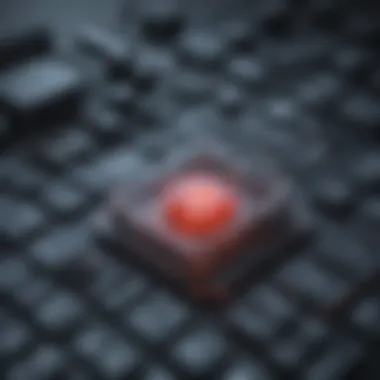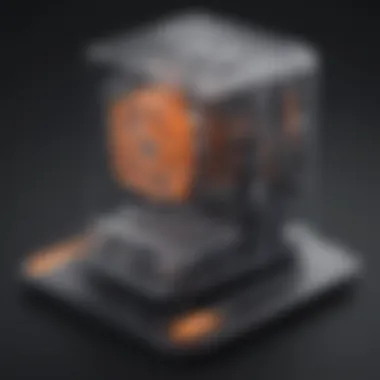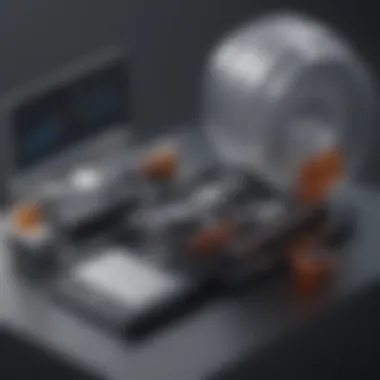Unlocking the Secrets of 3D Printing Software: A Beginner's Comprehensive Guide


Software Overview
3D printing software plays a crucial role in the realm of modern manufacturing. It acts as the bridge between digital designs and physical objects, enabling precise creation with intricate details. When considering 3D printing software, it is essential to evaluate factors such as user-friendliness, features, and affordability. This section will provide an insightful look into the key elements to consider when choosing the right software for your 3D printing projects.
- Introduction to the software: The software overview will include an in-depth analysis of popular 3D printing software options available in the market. It will explore their unique selling points, target user base, and compatibility with different 3D printers.
- Key features and functionalities: Understanding the core features and functionalities of 3D printing software is crucial for maximizing its potential. From slicing models for printing to adjusting print settings, this section will delve into the primary functionalities that make a software standout.
- Pricing plans and available subscriptions: Cost-efficiency is a significant factor for businesses and individuals looking to invest in 3D printing software. This part will highlight the pricing structures of various software options, including free trials, subscription models, and one-time purchase options.
User Experience
User experience plays a vital role in the efficiency and effectiveness of 3D printing software. A user-friendly interface, intuitive navigation, and robust customer support can enhance the overall printing experience for beginners and professionals alike. This section will focus on evaluating the user-centric aspects of different software solutions.
- User interface and navigational elements: The ease of navigating through a software interface can significantly impact user productivity. This segment will discuss the importance of a clean and intuitive UI with well-laid-out menus, toolbars, and shortcuts for easy access to key functions.
- Ease of use and learning curve: As beginners enter the world of 3D printing, software complexity can be a significant barrier. Evaluating the learning curve of different software options, along with the availability of tutorials and documentation, can help users streamline their workflow and enhance their skills.
- Customer support options and reliability: In times of technical challenges or queries, reliable customer support can be a saving grace. This part will shed light on the customer support channels provided by 3D printing software companies, including chat support, email assistance, and community forums.
Performance and Reliability
The performance and reliability of 3D printing software directly impact the quality and efficiency of the printing process. From processing speed to integration capabilities, this section will delve into the technical aspects that determine the software's effectiveness.
- Speed and efficiency of the software: Swift processing of complex 3D models is a key requirement for seamless printing. This segment will explore the performance metrics of different software solutions, highlighting speed benchmarks and optimization strategies.
- Uptime and downtime statistics: Availability is crucial in the realm of 3D printing, with downtimes leading to delays in production and workflow disruptions. Evaluation of uptime statistics and maintenance schedules is essential to ensure uninterrupted printing operations.
- Integration capabilities with other tools: Seamless integration with other design and manufacturing tools can streamline the workflow and enhance productivity. This part will discuss the compatibility of 3D printing software with CAD programs, slicers, and other software vital to the printing process.
Security and Compliance
Data security and regulatory compliance are paramount in modern business operations. For enterprises and professionals handling sensitive design files, ensuring the confidentiality and integrity of data is imperative. This section will delve into the security measures and compliance standards adopted by leading 3D printing software providers.
- Data encryption and security protocols: Protecting confidential design files and intellectual property is a top priority for 3D printing users. This segment will outline the encryption mechanisms and security protocols implemented by software vendors to safeguard user data.
- Compliance with industry regulations: Adherence to industry standards and regulations is essential for businesses operating in regulated sectors. This part will explore how 3D printing software aligns with data protection laws, export regulations, and intellectual property rights to ensure legal compliance.
- Backup and disaster recovery measures: Mitigating data loss risks through robust backup and recovery strategies is critical for business continuity. This section will address the backup procedures and disaster recovery plans incorporated by 3D printing software providers to protect user data from unforeseen events.
Introduction to 3D Printing Software
In the realm of 3D printing, software plays a pivotal role, acting as the cornerstone that bridges creativity with tangible outputs. It serves as the digital workshop where ideas transform into physical objects. Understanding the fundamentals of 3D printing software is indispensable for anyone venturing into this domain. This section delves into the essence of 3D printing software, shedding light on its nuances and guiding beginners through the intricate landscape of digital fabrication.
What is 3D Printing Software?
Definition and Functionality


At its core, 3D printing software is a sophisticated tool that facilitates the translation of digital models into physical objects through the process of additive manufacturing. Its primary functionality lies in converting computer-aided design (CAD) designs into layer-by-layer instructions that 3D printers can comprehend. The functionality of 3D printing software is pivotal in ensuring precision and accuracy in the printing process, making it a paramount choice for professionals and enthusiasts diving into the world of 3D printing technology.
Types of 3D Printing Software
Diverse classifications exist within 3D printing software, each tailored to specific user requirements and project complexities. From open-source platforms to proprietary solutions, the array of options caters to a broad spectrum of users. These software types vary in their features, interfaces, and compatibility with different printers, offering users versatility in selecting tools that align with their preferences and objectives in the 3D printing sphere.
Importance of Choosing the Right Software
Impact on Printing Quality
Selecting the appropriate 3D printing software significantly influences the quality and precision of the final output. The intricacies embedded within the software directly impact the intricacy and accuracy of the printed object, making it imperative to opt for software that aligns with one's project requirements. The right software choice enhances the sharpness and detailing of prints, reflecting the user's expertise and attention to detail within the finalized product.
Compatibility with 3D Printers
Ensuring seamless compatibility between the chosen software and the 3D printer is essential for a smooth printing workflow. Incompatibilities can lead to errors during the printing process, resulting in failed prints and wasted resources. Choosing software that harmonizes with the printer guarantees an optimized workflow, reducing the likelihood of technical hitches and enhancing overall efficiency in the fabrication process.
Key Features to Look for in 3D Printing Software
When delving into the realm of 3D printing software, understanding the significant aspects to consider becomes imperative. The key features of 3D printing software play a pivotal role in the overall printing process, contributing to the quality and efficiency of the final product. Advanced modeling tools stand as the backbone of any reliable software option, offering a myriad of benefits to users. These tools enable users to harness intricate designs and create complex structures with ease. Support for Different File Formats within these tools ensures compatibility and versatility, allowing users to work with various file types seamlessly. Customization Options provide users with the flexibility to tailor their printing experience according to specific requirements, enhancing control over the design and printing settings.
Advanced Modeling Tools
Support for Different File Formats
Support for Different File Formats is a critical component of 3D printing software, ensuring that users can import and export designs in a wide range of file types. This feature enhances the software's usability and compatibility, enabling users to work with designs from diverse sources and applications. The ability to support formats such as STL, OBJ, and STEP empowers users to explore a multitude of design possibilities and collaborate more effectively. By offering compatibility with various file formats, 3D printing software becomes a versatile tool that aligns with the evolving needs of users.
Customization Options
Customization Options amplify the user experience within 3D printing software, allowing for personalized workflows and settings. Users can fine-tune their printing parameters, such as layer thickness and infill density, to achieve optimal results based on specific project requirements. This level of customization grants users greater creative control and precision over their prints, ultimately leading to enhanced output quality. The ability to customize settings to suit individual preferences is a distinctive advantage of modern 3D printing software, catering to a diverse range of users and applications.
Slicing and Printing Settings


Layer Height Adjustment
The feature of Layer Height Adjustment in 3D printing software facilitates the control of layer thickness during the printing process. By adjusting the layer height, users can enhance the surface finish of their prints and achieve greater detail in intricate designs. This setting directly influences the quality and resolution of printed objects, allowing users to optimize print quality based on specific project requirements. The flexibility to modulate layer height ensures that users can strike a balance between printing speed and precision, tailoring the printing process to meet their desired outcomes effectively. Layer Height Adjustment serves as a fundamental tool in achieving consistent and high-quality 3D prints.
Print Speed Control
Print Speed Control is a vital aspect of 3D printing software that influences the efficiency and timing of the printing process. By adjusting print speed settings, users can optimize the balance between print quality and production time. Control over print speed allows users to expedite or slow down the printing process as needed, accommodating varying project intricacies and material requirements. This feature empowers users to achieve faster turnaround times without compromising the print's overall quality, offering a strategic advantage in time-sensitive printing projects.
Compatibility and Support
Cross-Platform Availability
The availability of 3D printing software across multiple platforms ensures accessibility and versatility for users across different operating systems. Cross-Platform Availability enables seamless transitions between devices and environments, facilitating a smoother and more convenient user experience. Whether operating on Windows, mac OS, or Linux systems, users can benefit from the flexibility and convenience of utilizing the software on their preferred platform. This compatibility fosters collaboration and workflow continuity, allowing users to work on their projects efficiently without platform limitations.
Customer Service and Community Forums
A robust support system comprising Customer Service and Community Forums significantly enhances the user experience within 3D printing software. Access to responsive customer service channels ensures that users receive timely assistance and solutions to any software-related queries or issues. Community forums provide a platform for users to engage with peers, share knowledge, and troubleshoot problems collectively. The interactive nature of these forums fosters a sense of community and collaboration among users, creating a rich environment for learning and exchanging insights. Customer Service and Community Forums serve as invaluable resources that augment user proficiency and satisfaction, elevating the overall user experience within the 3D printing landscape.
Exploring User-Friendly 3D Printing Software Options
When delving into the realm of 3D printing software, one crucial aspect to consider is the accessibility and user-friendliness of the tools available. Exploring user-friendly options opens up a pathway for beginners and enthusiasts alike to harness the power of 3D printing technology without being overwhelmed by complex interfaces or intricate features. By prioritizing ease of use and intuitive design, individuals can seamlessly transition into creating intricate 3D models and prototypes. Moreover, user-friendly software enhances the learning curve, allowing users to grasp fundamental concepts quickly and start bringing their creative visions to life.
TinkerCAD
Intuitive Design Tools
Tinker CAD revolutionizes the 3D design landscape through its intuitive design tools, simplifying the creation process for users at all skill levels. The key characteristic of TinkerCAD's intuitive design tools lies in their minimalist approach, focusing on essential features that facilitate streamlined model creation. This simplicity not only reduces complexity but also accelerates the design workflow, making TinkerCAD a go-to choice for beginners and professionals seeking efficient design solutions. The unique feature of TinkerCAD's intuitive design tools is their drag-and-drop functionality, enabling users to effortlessly position and manipulate various elements within their designs. While the simplicity of these tools enhances usability, some advanced users may find the toolset somewhat limiting for intricate projects.
Ideal for Beginners
Tinker CAD's reputation as an ideal platform for beginners stems from its uncomplicated interface and user-friendly tools, catering to individuals just starting their 3D printing journey. The key characteristic that makes TinkerCAD ideal for beginners is its gentle learning curve, providing guided tutorials and prompts to assist new users in mastering the basics of 3D design. This supportive environment cultivates confidence and encourages experimentation, essential qualities for beginners exploring the vast possibilities of 3D printing technology. Moreover, TinkerCAD's emphasis on simplicity and accessibility ensures that novices can quickly grasp fundamental concepts without feeling overwhelmed. While TinkerCAD excels in simplicity and ease of use, advanced users may find themselves craving more intricate features and customization options for complex projects.


Ultimaker Cura
Advanced Slicing Features
Ultimaker Cura sets itself apart with its advanced slicing features, offering users precise control over every aspect of the 3D printing process. The key characteristic of Ultimaker Cura's advanced slicing features lies in its detailed parameter settings, allowing users to fine-tune slicing configurations for optimal print quality. This level of control empowers users to adjust layer heights, print speeds, and infill patterns with precision, resulting in professional-grade prints. The unique feature of Ultimaker Cura's advanced slicing features is its adaptive algorithms that optimize print paths, reducing print times without compromising quality. While these advanced features provide unparalleled control, inexperienced users may find the plethora of options daunting and challenging to navigate.
Open-Source Platform
Ultimaker Cura's open-source nature amplifies its appeal by fostering a collaborative community-driven ecosystem. The key characteristic of Ultimaker Cura being an open-source platform lies in its transparency and flexibility, allowing users to modify and enhance the software according to their specific requirements. This freedom for customization attracts a diverse user base, ranging from hobbyists to industry professionals seeking tailored solutions for their 3D printing projects. The unique feature of Ultimaker Cura's open-source platform is the continuous integration of user-generated plugins and updates, ensuring a dynamic software environment rich in functionality. While the open-source nature of Ultimaker Cura promotes innovation, some users may encounter compatibility issues or lack of official support for certain customizations.
Simplify3D
Optimized Printing Processes
Simplify3D stands out for its optimized printing processes, maximizing efficiency and output quality for 3D printing enthusiasts. The key characteristic of Simplify3D's optimized printing processes lies in its algorithmic approach to generating support structures and optimizing print paths. This meticulous optimization results in faster print times, reduced material wastage, and superior print surface quality. The unique feature of Simplify3D's optimized printing processes is its customizability, allowing users to fine-tune printing parameters for specific filaments and models. While these optimized processes elevate print quality and efficiency, the software's price point and lack of frequent updates may deter budget-conscious users seeking continuous improvements.
Tailored Support for Various Printers
Simplify3D's commitment to providing tailored support for a wide range of 3D printers enhances its appeal among users with diverse hardware preferences. The key characteristic of Simplify3D offering tailored support for various printers lies in its extensive printer profiles and calibration settings, ensuring seamless integration with popular 3D printer models. This comprehensive database of printer profiles streamlines the setup process, eliminating compatibility issues and enabling users to start printing with minimal configuration. The unique feature of Simplify3D's tailored support is its multi-extrusion support, allowing users to create complex multi-color or multi-material prints with ease. While Simplify3D excels in printer compatibility and customizable settings, some users may find the lack of real-time updates for new printer models concerning.
Tips for Optimizing 3D Printing Software Performance
When delving into the realm of 3D printing software, optimizing performance is crucial for achieving high-quality results and enhancing the efficiency of your printing processes. In this section, we will explore key strategies and techniques to maximize the potential of your software, ultimately elevating the standard of your projects. By focusing on optimizing performance, users can streamline their workflow, reduce errors, and unleash the full capabilities of their chosen 3D printing software.
Regular Software Updates
Emphasizing the significance of regular software updates is imperative in ensuring that your 3D printing software remains at the forefront of innovation and functionality. By routinely updating your software, you gain access to the latest features and enhancements that can enhance usability, expand capabilities, and address any existing bugs or issues. Regular software updates are essential for maintaining compatibility with evolving technology trends and guaranteeing a seamless user experience. Stay tuned for a detailed overview of the impact of regular software updates in maximizing the potential of your 3D printing software.
Ensuring Latest Features and Enhancements
Are you eager to stay abreast of cutting-edge developments in 3D printing software? Ensuring the integration of the latest features and enhancements through regular updates is paramount in unlocking the full potential of your software. By incorporating new functionalities, tools, and performance improvements, you elevate the efficiency of your printing projects and stay ahead of the technological curve. The continuous evolution of features ensures that your software remains competitive and responsive to the dynamic needs of the 3D printing landscape. Discover more about the advantages and considerations of embracing the latest features and enhancements through regular software updates in the upcoming sections.
Calibrating Printing Settings
Calibrating printing settings plays a pivotal role in achieving precision results and optimizing the quality of your 3D prints. Fine-tuning the various parameters such as layer height, infill density, and print speed allows users to tailor their settings according to the specific requirements of each project. By adjusting these settings with precision, individuals can fine-tune the level of detail, strength, and adherence of their prints, ensuring superior output quality. Explore the nuances of calibrating printing settings and unravel the methodology behind achieving precise and impeccable results in 3D printing.
Utilizing Online Resources
Harnessing the power of online resources, including video tutorials and forums, can enrich your understanding of 3D printing software and unlock a treasure trove of insights and knowledge. Video tutorials offer visual guidance on software usage, design techniques, and troubleshooting tips, providing a multi-dimensional learning experience for users at all skill levels. On the other hand, engaging with community forums enables individuals to seek advice, share experiences, and collaborate with fellow enthusiasts, fostering a vibrant ecosystem of information exchange. Leverage the advantages of online resources to bolster your proficiency in 3D printing software and tap into a wealth of collective wisdom and expertise.







